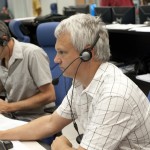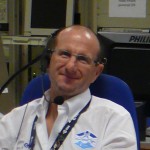The next issue of the ESA Bulletin is due out soon, and it includes an in-depth review of the upcoming ATV-3 mission with inputs from the engineers and project team members who have helped get Edoardo Amaldi ready for its mission. The editors have kindly sent along a few sections that had to be cut due to length, so we thought we’d post them here as a teaser. The team preparing ATV-3 for its launch in March is excited! These comments reveal what makes the mission special for them, what they find most challenging and how they aim to celebrate a success – Ed.
Kirsten MacDonell affectionately calls ATV Edoardo Amaldi ‘Eddie’. She has worked as ATV Cargo Integration Engineer since 2007. Although she had previously worked on packing cargo in ATV-2 (see some of our previous blog posts from Kirsten here – Ed.), it is not everyday work for her:
“New things always come up. For example, calculating the centre of mass is something we have to do for every ATV configuration. ATV is not generically qualified so there may be some loading configurations that can cause vibrations during launch that are bad for the hardware. So we build a model to test that the cargo configuration, including fluid and dry cargo, as well as the cargo layout, allow for a safe launch and rendezvous to the ISS. Sometimes it is like a puzzle.”
Fabio Caramelli calls himself ‘the propulsion guy’. He is responsible for all situations in which ATV-3 will be driven – approaching the ISS, docking and then separating again after six months. This is one aspect of the mission that is unique, he says.
“Most propulsion systems just have to work once – to bring the spacecraft in its position. But not the ATV-3 propulsion system. Apart from that, the dimensions of the system are extraordinary. Almost 7 tonnes of propellant and 32 engines – that is a huge system for a satellite.”
What also makes the ATV-3 mission special is the fact that the mission control team will be able to see ATV-3 approaching the ISS; pointing the cameras on the ISS in the [approaching] ATV’s direction will make this possible:
“So we not only have the mathematical data on our screens but also an actual image. That is very rare.”
Two situations will be most exciting for Caramelli:
“The critical phase begins right after ATV-3 separates from the launcher, two to six hours after the lift-off. And I will be even more nervous two to three hours before the docking.”

For Jean-Michel Bois, ESA Operations Management Team head at ATV-CC in Toulouse, responsibility for ATV-3 begins as soon as the vessel separates from its giant Ariane 5 launcher. He is responsible for every aspect of operations – including during the ISS attached phase – until re-entry:
“We are working very closely with the several agencies involved in the ISS programme. I think that this project is one of the most complex ones led by Europe.”
Finally, ATV-3 Campaign Manager Dominique Siruguet reveals what he is going to do when the mission is successfully completed: “When everything goes well, we are going to celebrate, including champagne, barbecue and a swimming pool.”




 Automated Transfer Vehicle page
Automated Transfer Vehicle page ATV blog archive
ATV blog archive
Discussion: no comments